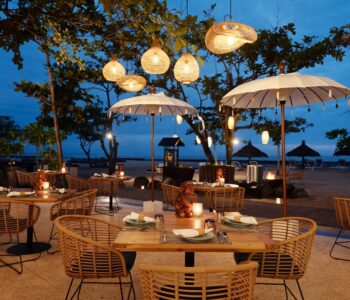Soaring high from the hills of Uluwatu, a magnificent copper-brass statue towers over the island.
You may see it airborne, as your plane descends for landing, but it’s visible from various locations on the island when you face southwards.
Garuda Wisnu Kencana, colloquially known as GWK Bali, is an iconic landmark located within the GWK Cultural Park. The park is a cultural learning and entertainment centre attracting residents and travellers all over; and it makes a great family day trip to Uluwatu.

More than a vast venue, the iconic landmark stands as the watcher of the island. The monument displays the Hindu God of Wisnu (Vishnu) riding the mythical Garuda bird. Lord Vishnu, in Hindu mythology, is the protector of the Universe and its equilibrium, whilst his companion the mighty eagle-like Garuda represents loyalty and selfless devotion; and incidentally is the national emblem of Indonesia representing freedom.
Here are more fascinating facts about GWK Bali that you may not know.
1. A record-breaking landmark

Rising at the height of 122 metres on a concrete pedestal, the behemoth GWK statue is the third largest statues in the world — higher than New York’s Statue of Liberty (93 metres) and Brazil’s Christ the Redeemer (38 metres). The Spring Temple Buddha monument in Henan, China is at 128 metres, whilst the Statue of Unity in India scrapes the sky at 182 metres, retaining its status as the world’s tallest statue.
2. A long-term affair
GWK Bali underwent a 16-year hiatus due to financial woes. Originally designed in 1990, the actual construction only began in 1997. The total duration of the work, from concept to finish, took a staggering 28 years.
3. From coast to coast

Masterminded by a renowned Balinese sculptor I Nyoman Nuarta, the project is in fact a collaboration of 120 artists, fashioned at Nuarta’s workshop NuArt in Bandung, West Java. The monument is believed to be the heaviest statue in Indonesia, bearing 4000 tonnes of copper, brass, and steel. Its parts were transported over from Bandung to Bali over 1000 km by trucks to be installed in the cultural park.
4. A heed to humans

The statue depicts Vishnu in a meditative state, with the eyes partially closed, and atop his mount, the faithful Garuda. The belief is they are inseparable. Garuda holds a promise to Vishnu to be his perennial vehicle as a token of gratitude for freeing his mother from slavery.
Garuda in the ancient lore symbolises humans in the modern day. Whilst the universe gifts life, the human is responsible for the protection and preservation of nature’s wealth.
5) With great power comes great responsibility
Made with copper from Japan, China, and Latin America; brass from Germany; and a skeleton structure made from non-corrosive stainless steel, GWK Bali was designed to withstand Bali’s tropical storms as well as earthquakes to last the next 100 years, reportedly. Some have claimed it could resist earthquakes up to magnitude 8 and wind velocity up to 350 km/hour.
6) A jam-packed Bali day trip

Spanning over 60 hectares of land, GWK Bali has 21 points of interests ranging from a food court, photo studio, a Segway trail to a cinema! The colossal Garuda Wisnu Kencana statue isn’t the sole feast for the eyes, as they host various kinds of Balinese art performances – equally as captivating.
The Garuda Wisnu Kencana Cultural Park provides a glimpse into the fascinating heritage of Bali through cultural performances, legendary folklore tales, grand sculptures, and cinematic presentations. Its immense outdoor area makes it perfect for a day trip to get in touch with culture as well as nature.









